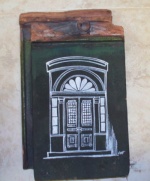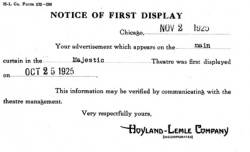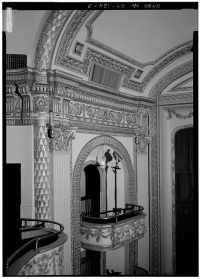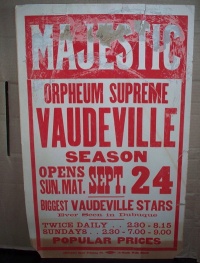Encyclopedia Dubuque
"Encyclopedia Dubuque is the online authority for all things Dubuque, written by the people who know the city best.”
Marshall Cohen—researcher and producer, CNN
Affiliated with the Local History Network of the State Historical Society of Iowa, and the Iowa Museum Association.
MAJESTIC THEATRE
MAJESTIC THEATER. Predecessor of the Orpheum Theater, the anchor of the FIVE FLAGS CIVIC CENTER. The earliest building was built on the site at Fourth and Main in 1840 by Emerson and Crider. Here the Express and later the Herald were issued. This was called the "Democratic Corner."
In 1846 the building became the CITY HOTEL. It was repeatedly remodeled and renamed. This background made the location the record holder for having the longest history of being a theater site west of the MISSISSIPPI RIVER.
After the fire destroyed the New Bijou, the site was quickly developed as the first theater designed by the Chicago firm of C. W. Rapp and George Rapp, eventually the leading theater designers in the United States. (1) Built in 1910 at a cost of $90,000 in the style of Renaissance-Flemish architecture, the Majestic was said to be a replica of a Paris theater. The theater was converted to a movie house in 1920.
In 1929 Jake Rosenthal, a noted theater operator who had been with the theater since 1904, ended his history with the building. He had renovated the building in the Bijou and later New Bijou. When the Majestic was constructed, he was responsible for bringing talking movies to the city. (2)
The building was renamed "The Spensley" when it opened November 16, 1929. (5) Its first program was a presentation of the talking motion picture, "Rio Rita." (5) Jack Dempsey, former heavy-weight champion boxer of the world, and his vaudeville act "A Roadside Razz" appeared at the theater in 1930. (3) The stage was turned into a huge cooking school with demonstrations of "ranges, refrigerators, and other culinary equipment" in 1933. (4)
In 1932 the operation became part of the RKO film theater circuit and was renamed the RKO Orpheum. (1)
By 1969 the Orpheum along with much of the area around Lower Main Street was suffering poor economic times. The theater was scheduled for demolition as part of a twelve-block urban renewal project. Led by such community activists as Wayne Andrew NORMAN, Sr., a group developed the idea that private donations could be collected to renovate the theater into part of an exhibition-arts facility. The project was named for the five national flags that have flown over this area.
In December 1971 the fund drive was launched. In July 1972 architects were hired to design the facility. In November 1972, the Orpheum was placed on the NATIONAL REGISTER OF HISTORIC PLACES. (1) The theater was restored in 1975, renamed the Five Flags Theater and reopened March 13, 1976. With restoration, the main floor seats 322, the balcony 357, and the boxes 38 for a total of 717. The theater has been used annually for performances of the DUBUQUE SYMPHONY ORCHESTRA.
On August 17, 1976, an overwhelming 70% of the voters approved a bond referendum for the construction of the Five Flags Civic Center. (1) Besides the arena, which covered 27,000 square feet of floor space and seats up to 4,000, the new plan called for theater support rooms, locker rooms, storage space, and administrative offices. The complex was connected to and designed to complement the restored theater. The new civic center opened its doors in 1979.
---
Sources:
1. "Theater at Fourth and Main," Online: http://fiveflagscenter.com/AboutUs/History.aspx
2. "Owners to Operate Majestic Theatre Beginning Sept. 1," Telegraph Herald and Times Journal, Aug. 18, 1929, p. 27
3. "Dempsey Comes Here Wednesday," Telegraph Herald and Times Journal, April 1, 1930, p. 5
4. "Make Spensley Theatre Ready for Cooking Demonstration," Telegraph Herald and Times Journal, Apr. 11, 1933, p. 5
5. "Spensley Theatre to Open November 16th," Telegraph Herald and Times Journal, Nov. 10, 1929, p. 22









